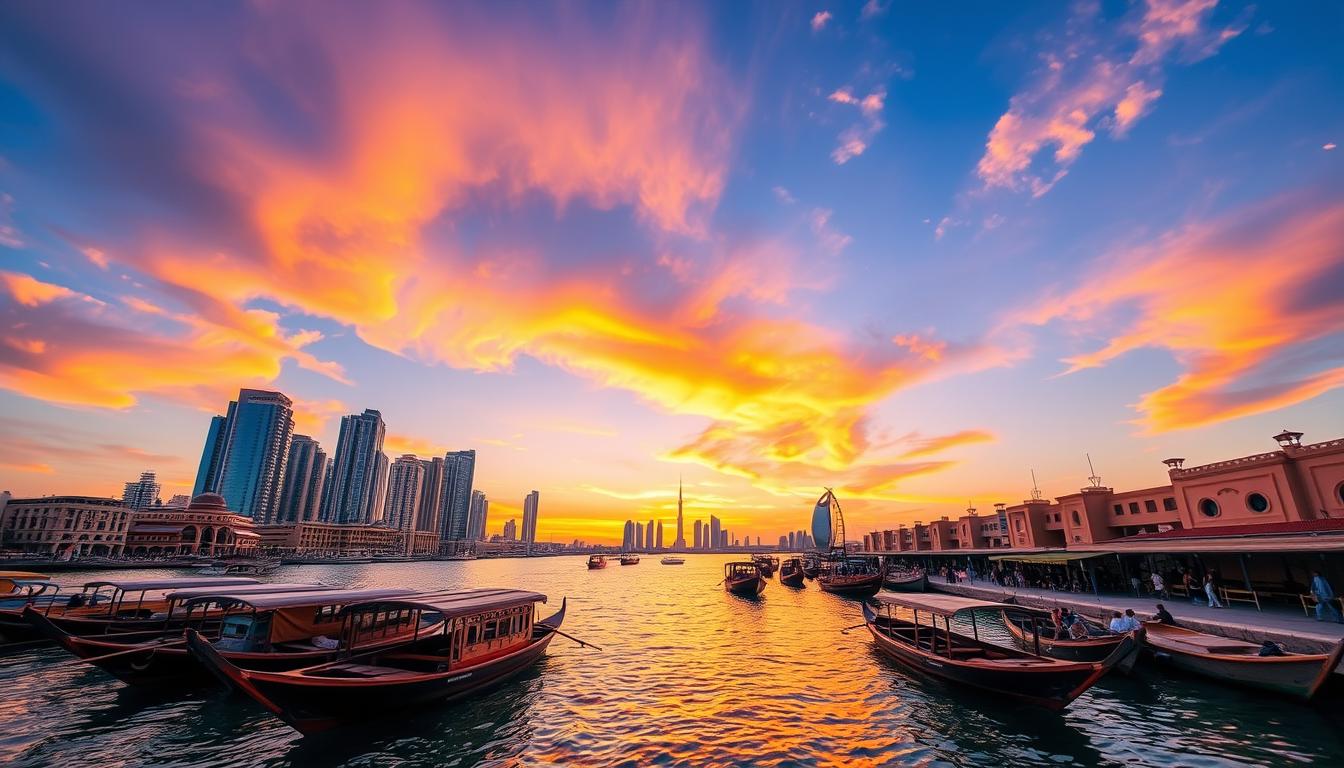
- 1.4k Views
- 15 Min Read
- (0) Comment
Have you ever stood by a river and felt a city’s pulse? That was my experience at Dubai Creek. This waterway is more than a scenic beauty. It is the heart of Dubai, connecting cultures and dreams over time. It’s where trade, traditions, and communities began.On a traditional wooden abra, excitement filled me. I imagined the lives of the ancient pearl divers and traders. Before oil, these waters were Dubai’s lifeline. The Spice Souk with its dazzling scents and the shiny treasures of the Gold Souk showed me Dubai’s enduring legacy. Join me in discovering the stories of Dubai Creek.
Key Takeaways
- Dubai Creek is the heartbeat of Dubai’s rich history, serving as a lifeline for early settlers.
- Traditional abra boats offer stunning views of the city, connecting old and new in one scenic ride.
- The Spice Souk and Gold Souk reflect Dubai’s trading heritage, offering unique shopping experiences.
- Merchant dhows continue to play an essential role in Dubai’s vibrant trade activities.
- Dubai Creek is a hub for culture, commerce, and continuous discovery!
Introduction to Dubai Creek's Significance
Dubai Creek is a testament to the city’s rich past and culture. It’s over 9 miles long, serving as a vital port. This waterway is key for trade and travel, showing visitors the area’s dynamic history.
Overview of Dubai Creek's Role in Local Culture
Dubai Creek does more than help with transport. It’s where people meet and where business happens. Its history attracts traders and tourists, offering a mix of traditions and foods. This shows the city’s evolving culture.
Geographical Importance in Trade and Transportation
Dubai Creek is crucial for trade, with over 13,000 ships passing annually. It’s wide enough for many vessels, which helps with moving goods. Since 1902, it’s been a free trade zone, boosting Dubai’s growth. For more on this area, check out this resource!
| Feature | Specifications |
|---|---|
| Length | 9 miles (14 km) |
| Annual Ship Traffic | Over 13,000 ships |
| Average Width | 200 – 1,200 meters |
| Average Depth | 6.5 – 7 meters |
| First Bridge | Al Maktoum Bridge (1963) |
| Year of Dredging | 1961, 1955, and further expansions |
The Early Beginnings of Dubai Creek
Dubai Creek’s history goes back thousands of years. Archaeological digs around Dubai Creek have shown important signs of early human activity. Sites like Hatta, Al Qusais, and Jumeirah show that people lived there from around 3000 B.C.
This long history shows Dubai Creek was crucial for early settlements. It was a key water source. This influenced the lives of those along its banks greatly.
Archaeological Discoveries in the Area
Research along Dubai Creek has found many layers of ancient cultures and communities. They thrived thanks to plentiful resources. Items like pottery, tools, and old home remains help us understand how people once lived.
These finds at Dubai Creek offer a peek into a time when the area depended on fishing and trade.
The Role of Water Sources in Early Settlements
Early settlements needed water, and Dubai Creek was vital. It was a natural path for moving goods and people. The Creek’s waters also offered food and chances for making a living.
This relationship with water was crucial for the early people of Dubai. It helped build a society that would change and grow through the years.
The Growth of Trade and Commerce
Dubai Creek blossomed into a vibrant Dubai Creek trade hub. It’s been a center for merchants and traders for centuries. Its location made it a gateway for all sorts of goods and cultures. This sealed its place in Dubai trading history. The growth of trade along the creek boosted the area’s economy. It made the creek an essential part of the region’s past and future.
How Dubai Creek Became a Trade Hub
In the 1800s, Dubai Creek became a major trade center. Traders from around the world came to this natural port. They exchanged a wide range of goods, even before modern ships were invented. This activity laid the foundation for Dubai’s rise in commerce.
Key Goods Traded Through the Creek
The goods traded through Dubai Creek were many and varied. Here are some key products that shaped the market:
| Goods | Regions of Origin | Significance |
|---|---|---|
| Textiles | India | Luxury and trade network expansion |
| Spices | Arabian Peninsula, Africa | Culinary enhancement and trade staple |
| Pearls | Oman, Persian Gulf | Led to the rise of Dubai pearl diving industry |
| Gold | Signified wealth and value, important for local economy |
By the mid-20th century, Dubai Creek saw major improvements. These upgrades included deepening the creek for bigger ships and adding key infrastructure. The discovery of oil in the 1960s fueled rapid growth. It changed the area’s look and made it a global trading leader.
The Development of the Maritime Industry
The maritime industry in Dubai has a rich and captivating legacy, deeply tied to its heritage. Traditional dhows are not just a means of transport but also a cultural icon. They connect to the city’s history. As trade grew, these vessels changed to meet the port’s bustling needs. They evolved in design and function to support the thriving trade environment.
The Evolution of Traditional Dhows
For centuries, traditional dhows have been vital to Dubai’s maritime operations. Their design was perfect for the Arabian Gulf, aiding in fishing and pearling. These industries were key for the local communities. Over time, these boats added modern materials but kept their classic look. This shows Dubai’s skill at mixing tradition with modernization.
The Impact of Fishing and Pearling Industries
The Dubai fishing industry fed local people and boosted the economy. The creek was a lively spot where fishermen sold their catch. This fueled a love for fresh seafood. Pearl diving deepened the bond between residents and the sea, adding to both emotional and economic value. These traditions are alive in dances and foods you can explore today. For more on these cultural experiences, visit this link.
Cultural Influences Shaping Dubai Creek
Dubai Creek’s vibrant cultural scene mixes Arab culture with influences from nearby areas. It shows how different cultures have developed the community, business, and social life over time.
The Impact of Arab Culture on the Creek’s Development
Arab culture is key to Dubai Creek’s identity. Sites like the Sheikh Saeed Al Maktoum House show the royal family’s impact. At the Shindagha Museum, visitors learn about the UAE’s culture and traditions. The busy Gold Souk and Spice Souk highlight how trade influenced local customs.
Influences from Persian and Indian Traders
Persian and Indian traders have also shaped the Creek. Traditional dhows on the water remind us of old trade routes. Riding sea abras shows the city’s old way of moving around. The Al Fahidi district’s buildings reflect Persian and Indian styles, marking their lasting influence on Dubai Creek.
| Influence | Description |
|---|---|
| Arab Culture | Shaped through traditions, architecture, and powerful historical figures. |
| Pursuit of Trade | Creation of markets and souks showcasing Emirati hospitality and craftsmanship. |
| Persian & Indian Traders | Introduced diverse goods, contributing to the Creek’s identity as a bustling trade hub. |
Dubai Creek is a melting pot of cultures, bringing people together. Parks along the Creek are where everyone meets, sharing laughter and stories. This mix of cultures keeps Dubai Creek’s legacy alive, inviting everyone to explore and connect.
The British Era and Its Effects
The arrival of British influence changed Dubai Creek greatly. It started a key time when trade practices were changed a lot. The British Protectorate made Dubai a free port. This move attracted merchants worldwide. This time led to a big jump in economic activity. It changed Dubai’s colonial trade and started the modern commercial ways.
The Establishment of British Protectorate
In 1892, Dubai became under British control. This brought big changes in how things were run and in trade. By 1894, Dubai made a smart move. It stopped taxing foreign traders, which made many merchants come to Dubai. This rule helped the city grow. It also made Dubai more diverse. By the end of the 1800s, a lot of people living in Dubai were from other places.
Changes in Trade Practices During Colonial Rule
British influence changed how trade was done in Dubai Creek. A big moment was in 1903. Then, Dubai managed to become a stop for a big British shipping line. This made more foreigners do business there and increased trade. Over time, the creek became a main path for different goods. This helped Dubai’s colonial trade get better. The changes during this time prepared Dubai for its future growth. This was especially true when oil money started to come in.
| Year | Event | Impact |
|---|---|---|
| 1892 | Dubai became a British protectorate | Restructured governance and trade policies |
| 1894 | Tax exemption for foreign traders | Increased foreign merchant presence |
| 1903 | Steamship line adds Dubai as a port | Boosted foreign trade activity |
| 1912-1958 | Sheikh Saeed bin Maktoum’s reign | Prominent growth during the pearl industry |
Dubai Creek in the 20th Century
The 20th century transformed Dubai Creek profoundly. Significant advancements in infrastructure reshaped its economic importance. Notably, the discovery of oil after these developments marked a new era, making the Creek a key economic player.
Major Developments in Infrastructure
Several key projects marked Dubai Creek’s growth throughout the century. The 1960s dredging allowed larger ships to dock, boosting maritime commerce. In 1994, Dubai Creek Park was developed, offering a vast green space for recreation. The Dubai Creek Golf & Yacht Club further attracted international visitors, adding leisure appeal to the area.
The Role of Dubai Creek During Economic Expansion
As Dubai’s economy grew, the Creek’s importance surged. It symbolized Dubai’s global ambitions. Dhows carrying goods like dried lemons and spices navigated its waters, making it a commercial hub. The documentary ‘The Floating Life of Dubai Creek’ highlighted its rich heritage and urban blend. Since its 2017 UNESCO World Heritage Site submission, Dubai Creek has been recognized for its historical value in Dubai’s modern landscape.
| Infrastructure Development | Year | Impact |
|---|---|---|
| Dredging of Dubai Creek | 1960s | Increased capacity for larger ships, boosting commerce |
| Dubai Creek Park | 1994 | Enhanced recreational space for visitors |
| Dubai Creek Golf & Yacht Club | 1990s | Attracted international tourism |
| UNESCO Heritage Site Submission | 2017 | Recognized historical significance |
The Transformation of Dubai Creek Today
Dubai Creek is now a vibrant mix of history and innovation. It attracts those interested in culture and adventure. There are many modern attractions for visitors, offering chances to explore, eat, and try new things.
Modern Attractions Along the Creek
On the waterfront, you can see the impressive Dubai Creek Tower. It’s set to be the world’s tallest structure. There are luxurious apartments, top-notch shops, and eateries with both global and local dishes. Also, parks and gardens add green spaces, perfect for walks or picnics.
How Tourism Has Changed the Landscape
Tourism has reshaped Dubai Creek, bringing constant growth. Projects like Dubai Creek Harbour provide upscale living and modern comforts. Nightlife now includes lively markets and chic places to experience Emirati culture. Plus, getting around is easy with a great transport system and electric car stations.
| Attraction | Description | Year Developed |
|---|---|---|
| Dubai Creek Tower | Set to be the tallest tower globally, a symbol of modern Dubai. | Under construction |
| Dubai Creek Golf & Yacht Club | A premier destination for golfing and leisure activities. | 1989 |
| Dubai Creek Harbour Mall | An extensive shopping center featuring luxury brands and boutiques. | 2019 |
| Dubai Waterfront | An 8-kilometer waterfront for recreation and leisure. | Construction began 2007 |
Environmental Aspects of Dubai Creek
The Dubai Creek is crucial for many plants and animals. It shows the stunning natural beauty and diversity of the area with important Dubai Creek environmental aspects. Keeping this place healthy is key for local wildlife and people alike.
Importance of Conservation Efforts
Protecting the Creek’s natural spaces is at the heart of Dubai conservation work. The Ras Al Khor Wildlife Sanctuary is a prime spot for this. It’s home to birds that travel long distances and local animals. It shows Dubai’s efforts to keep nature safe while the city grows.
Flora and Fauna Native to the Creek
Walking near Dubai Creek, you’ll find many plants and animals. You’ll see mangroves and plants that handle salt water well. The waters are full of fish and shellfish. This area lets you see nature living in peace, highlighting Dubai Creek environmental aspects and the city’s care for nature.
Future Prospects for Dubai Creek
The future of Dubai Creek looks very promising. Urban development is pushing forward, combining old with new beautifully. This blend honors Dubai Creek’s history while focusing on community growth. It aims to improve life quality for everyone living there.
Urban Development Plans in the Area
Dubai Creek Harbour is a huge project by Emaar, stretching over 5.6 million square meters. It mixes homes, workplaces, and places for fun evenly. It plans to home about 48,500 units for nearly 175,000 people. The fully finished area will have lots of houses, office spots, and shops. Dubai Square will be a big shopping area, covering 750,000 square meters!
Integrating History with Future Growth
The growth plans for Dubai Creek are impressive. They offer modern living while respecting traditions. It will have schools, hotels, hospitals, and parks. The Creek Tower will be a new landmark, likely the tallest building in the world.
Parks and places for boats, including a big marina, show a focus on community and sustainability. People can enjoy a calm life in a lively city setting. Dubai Creek combines great facilities with cultural values. This makes it a top choice for people and businesses looking to move.
Conclusion: The Enduring Legacy of Dubai Creek
Dubai Creek has a special story to tell. It shares Dubai’s rich past and cultural growth. This waterway is a symbol of Dubai’s history, showing the impact of traditions on today’s vibrant city.
Every visit uncovers its old charm. You see traditional abra boats and the mix of art and culture that marks this place.
Reflecting on its Historical Significance
Walking along the Historic District Promenade, history feels alive. Old wooden boats, key for trade back then, remind us of Dubai Creek’s sea history. Craftsmen keep the abra boats’ legacy alive, showing their skill and commitment to tradition.
The Maritime House in the Historic District Museum shows Dubai’s respect for its history.
Encouraging Future Generations to Explore
There’s so much for the next generations to discover at Dubai Creek. There are art pieces that mix old Emirati styles with new looks and hands-on exhibits like the Historic District Tunnel.
Kids can learn about pearl diving at the Pearl Dive Experience or enjoy Arabic poetry at the Poetry House. Dubai Creek is a place where the past and future meet, inspiring a love for heritage.
Resources for Further Exploration
Looking to learn more about Dubai Creek’s history? You’re in the right place! From history enthusiasts to the simply curious, there’s something for everyone. Begin with books that detail the Creek’s evolution throughout the years.
Recommended Books and Articles
Consider picking up *Dubai: A Pioneer in Global Development*. Also, check out the *Journal of Arabian Studies*. They offer insights into Dubai Creek’s historic and modern roles. These resources help link Dubai’s past, present, and future, deepening your grasp of this cultural hotspot.
Museums and Tours Highlighting Dubai Creek
Explore local highlights like the Al Fahidi Historical Neighbourhood. Its Arabian architecture is breathtaking! Also, don’t skip the Etihad Museum to learn about the UAE’s heritage and founding stories.
For an unforgettable experience, try a night dhow dinner cruise on Dubai Creek. This adventure lets you see the stunning skyline and feel the harbor’s rich history.
FAQ
What is the significance of Dubai Creek in local culture?
Dubai Creek is the heart of the city. It has been vital for trade and social life. It turned Dubai into a busy marketplace, thanks to its trade routes.
How did trade develop along Dubai Creek?
Dubai Creek’s perfect location made it a key trade center. Merchants from the Arabian Peninsula, India, and Africa met here. They traded textiles, spices, and pearls, boosting the local economy.
What archaeological discoveries have been made around Dubai Creek?
Discoveries around Dubai Creek show it’s been home to people for thousands of years. It played a big role for ancient fishing and trading civilizations.
How has the maritime industry influenced the development of Dubai Creek?
Traditional dhows define Dubai Creek’s maritime past. They were central to the pearling and fishing industries. These vessels were the lifeblood for the area’s people.
What cultural influences can be seen in Dubai Creek?
Dubai Creek reflects Arab, Persian, and Indian cultures. These influences are seen in its architecture and market vibe. This mix makes it a rich culture spot.
How did British colonial rule affect Dubai Creek?
With British rule, Dubai Creek turned into a free port. This attracted traders from all over and boosted the economy during colonial times.
What developments occurred in Dubai Creek during the 20th century?
The 20th century brought major changes to Dubai Creek. Infrastructure projects linked to the oil discovery elevated it. It became a key player in Dubai’s growth as a global city.
What modern attractions can be found along Dubai Creek?
Dubai Creek now hosts modern spots like Dubai Creek Tower. There are also places to eat and relax. It mixes the old with the new, drawing in tourists.
What is the environmental significance of Dubai Creek?
Dubai Creek is important for its plants and animals. Keeping it eco-friendly is key. The Ras Al Khor Wildlife Sanctuary shows Dubai’s effort to stay green.
What are the future prospects for Dubai Creek?
There are plans to blend Dubai Creek’s history with its future development. This ensures it remains lively. It will cherish its past while growing modernly.
Where can I find resources to learn more about Dubai Creek’s history?
For a closer look, check out books, articles, and guided tours. They offer a rich experience. They help visitors connect with Dubai Creek’s historical and cultural depth.
Categories
- dirt bike (4)
- Uncategorized (4)
- Desert Buggy Rental (1,397)
- Dune buggy (4)
- Quad Bike Rental (1)
- Desert safari (1)
- Hot air ballon (2)
Recent Post
Tags
Al Ula dune buggy tours Ballooning Velocity Balloon ride positions best desert safari in dubai Best Family Activities in Dubai Camel ride apparel tips Clothing Tips for Dubai Balloon Rides Cost of living in Dubai and Abu Dhabi Customary tipping in ballooning Desert Adventure Dubai Desert distances Desert hot air balloon experience Desert Safari Limitations Dress attire for hot air balloon ride Dubai balloon ride cost Dubai desert excursion prices Dubai excursions for families Dubai Shopping Dubai trip cost breakdown Dubai vs. Abu Dhabi Exploring Dubai's deserts Extreme Desert Activities Extreme heat in desert safaris Extreme Sports High-end Dubai tourism Hot air balloon adventure Dubai Hot Air Balloon Duration Hot air balloon regulations Hot Air Balloons Hot Air Balloon Turbulence Hot desert nights Luxury Desert Tours Modest clothing for women Mojave Desert ot air balloon dubai booking Outdoor activities in UAE Palm Jumeirah Passenger Weight Checks Quad Biking Adventure Religious tolerance in Dubai Sand dune thrill Standard vs Deluxe Travel Comparison Tunisia Sahara Weight and Ziplining Experience



